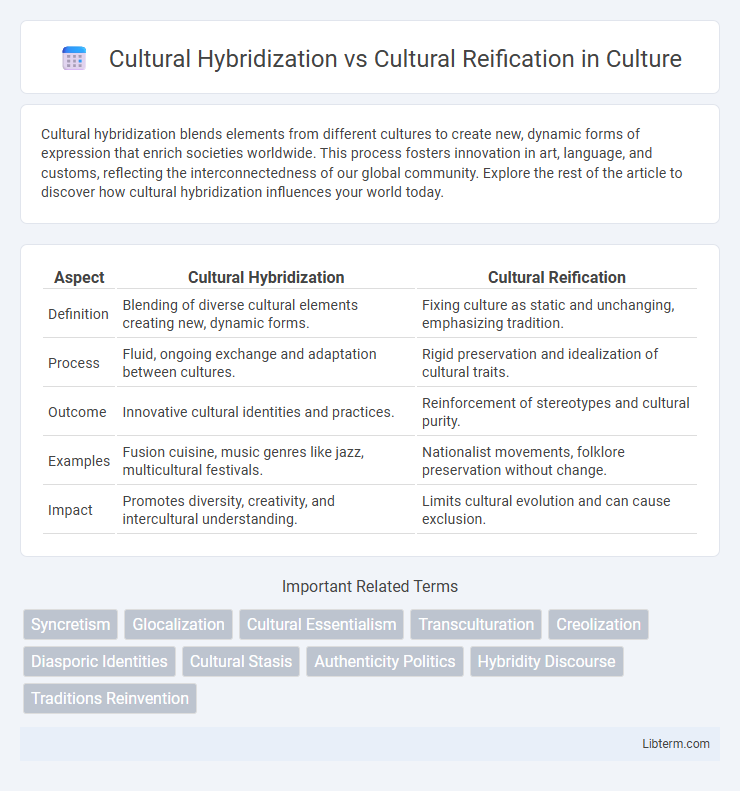Cultural hybridization blends elements from different cultures to create new, dynamic forms of expression that enrich societies worldwide. This process fosters innovation in art, language, and customs, reflecting the interconnectedness of our global community. Explore the rest of the article to discover how cultural hybridization influences your world today.
Table of Comparison
| Aspect | Cultural Hybridization | Cultural Reification |
|---|---|---|
| Definition | Blending of diverse cultural elements creating new, dynamic forms. | Fixing culture as static and unchanging, emphasizing tradition. |
| Process | Fluid, ongoing exchange and adaptation between cultures. | Rigid preservation and idealization of cultural traits. |
| Outcome | Innovative cultural identities and practices. | Reinforcement of stereotypes and cultural purity. |
| Examples | Fusion cuisine, music genres like jazz, multicultural festivals. | Nationalist movements, folklore preservation without change. |
| Impact | Promotes diversity, creativity, and intercultural understanding. | Limits cultural evolution and can cause exclusion. |
Introduction to Cultural Hybridization and Reification
Cultural hybridization refers to the dynamic process where distinct cultural elements blend, creating new, hybrid identities and practices that challenge traditional boundaries. Cultural reification involves treating culture as a fixed, unchanging entity, often leading to stereotyping and essentialism. Understanding these contrasting concepts sheds light on how cultures evolve or become rigidly defined in social contexts.
Defining Cultural Hybridization
Cultural hybridization refers to the dynamic process through which distinct cultural elements blend, producing new, syncretic cultural forms that transcend traditional boundaries. Unlike cultural reification, which treats culture as fixed and unchanging, hybridization emphasizes fluidity, adaptation, and the continuous exchange of ideas, practices, and symbols across diverse social groups. This concept is central to understanding globalization's impact on cultural identity and transformation.
Explaining Cultural Reification
Cultural reification involves treating dynamic cultural expressions and social practices as fixed, rigid entities, thereby ignoring their fluid and evolving nature. This process often leads to stereotyping and essentializing groups, reducing complex identities to simplistic and static categories. Understanding cultural reification is crucial for recognizing how cultural meanings are socially constructed rather than inherent or immutable.
Key Differences Between Hybridization and Reification
Cultural hybridization involves the dynamic blending and creation of new cultural forms through the interaction of diverse traditions, emphasizing fluidity and innovation. Cultural reification, in contrast, treats culture as a fixed, unchanging entity, often solidifying and essentializing cultural traits into rigid categories. The key difference lies in hybridization's focus on cultural exchange and transformation, whereas reification centers on preserving and defining culture as static and immutable.
Historical Contexts of Cultural Mixing
Historical contexts of cultural mixing reveal distinct dynamics between cultural hybridization and cultural reification; hybridization occurs through the blending of customs, languages, and practices forming new, dynamic cultural expressions as seen in colonial and postcolonial societies. In contrast, cultural reification solidifies aspects of culture into fixed, essentialized identities often used to reinforce power structures and resist change, evident in nationalist movements privileging homogenous traditions. The interplay between these processes shapes how societies negotiate identity, heritage, and cultural evolution over time.
Impacts of Globalization on Cultural Identity
Cultural hybridization fosters the blending of traditions, languages, and customs through globalization, leading to dynamic, evolving cultural identities that reflect global interconnectedness. In contrast, cultural reification emphasizes the rigid preservation and commodification of cultural elements, often resulting in static, essentialized identities used to assert authenticity in a global market. The tension between hybridization and reification shapes how communities negotiate cultural identity amid globalization's pressures, influencing social cohesion, heritage preservation, and intercultural dialogue.
Benefits and Drawbacks of Cultural Hybridization
Cultural hybridization fosters innovation and cross-cultural understanding by blending diverse traditions, creating dynamic and inclusive identities that drive social and economic growth. However, it may also lead to cultural dilution, loss of heritage, and identity confusion as original cultural meanings become blurred or commodified. Balancing cultural preservation with the integration of new influences is essential to maximize the benefits of hybridization while minimizing its drawbacks.
Consequences of Cultural Reification in Modern Societies
Cultural reification in modern societies often leads to the rigid stereotyping and essentializing of cultural identities, which can hinder social integration and fuel ethnic or racial tensions. This process freezes dynamic cultural practices into fixed, commodified symbols, diminishing the richness of cultural diversity and perpetuating exclusionary narratives. Consequently, cultural reification undermines social cohesion and stifles intercultural dialogue, challenging the potential for multicultural harmony and mutual understanding.
Real-World Examples: Hybridization vs Reification
Cultural hybridization manifests in examples like global cuisine fusion, where traditional foods from different cultures blend to create innovative dishes, such as Korean-Mexican tacos. In contrast, cultural reification occurs when stereotypes solidify, like the fixed portrayals of Native American tribes in media that ignore cultural diversity and change. These contrasting processes reveal how dynamic cultural exchanges promote evolution, whereas reification freezes culture into static, often inaccurate representations.
Future Trends in Cultural Dynamics
Future trends in cultural dynamics indicate a growing prevalence of cultural hybridization, driven by increased globalization and digital interconnectivity fostering the blending of traditions, languages, and practices across societies. In contrast, cultural reification, which involves the rigid preservation and idealization of cultural elements, may face challenges as fluid identities and cross-cultural exchanges become more dominant in shaping collective cultural narratives. Emerging technologies like virtual reality and augmented reality are expected to accelerate hybrid cultural experiences, enabling immersive participation in multiple cultural contexts simultaneously.
Cultural Hybridization Infographic

 libterm.com
libterm.com